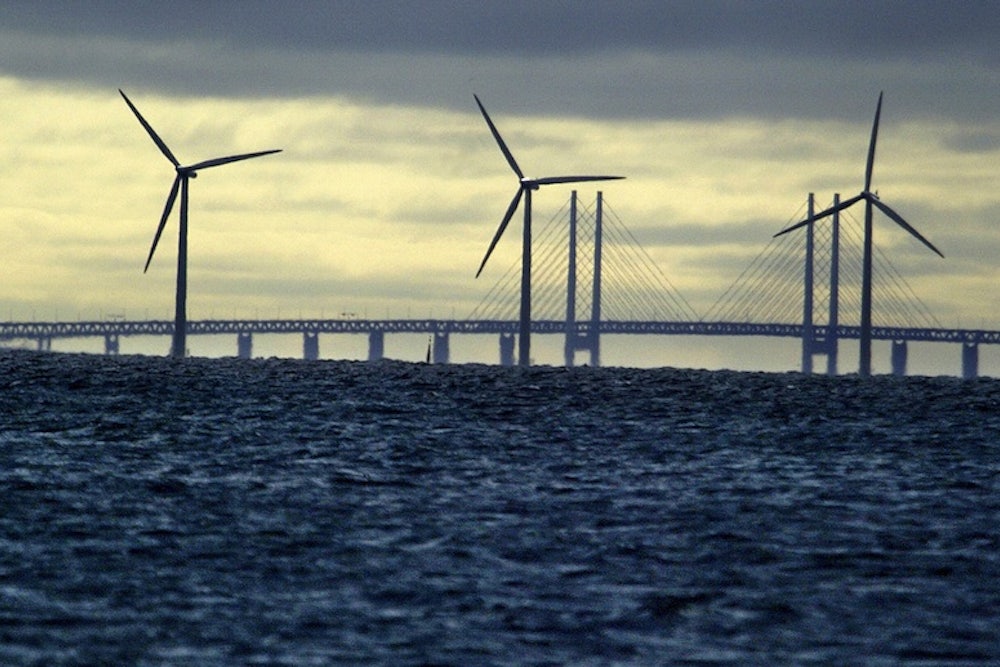Hurricane Sandy was Mark Jacobson’s light bulb moment. A professor of civil and environmental engineering at Stanford University, he was simultaneously running three separate experiments—one that that utilized complex computer models to simulate hurricanes, another testing the impact wind turbines have on the atmosphere, and a third examining the energy infrastructure of New York—when the storm hit.
“It was almost the perfect coincidence of events,” says Jacobson. “So the question arose, if you have a lot of offshore wind off New York, would the hurricane destroy the turbines?”
So he plugged in “tens of thousands” of wind turbines into his models, placing them within 100 kilometers off the coast in water depths ranging from 30 to 200 meters. Then he ran simulations for three different hurricanes: Katrina, Isaac, and Sandy. Not only were the turbines undamaged by the conditions, they also disrupted peak winds by up to 92 percent and storm surge by up to 79 percent. In the case of Katrina, 78,000 wind turbines decreased wind speeds by 80 to 98 miles per hour.
“When you put wind turbines in, they slow the wind of the hurricane, which decreases the wave heights and the movement of air to the center of the hurricane,” he says. “This increases the central pressure which makes the hurricane dissipate faster.”
Jacobson’s findings, recently published in the journal Nature Climate Change, seem to offer an almost too-good-to-be-true solution to a precarious situation. According to the NOAA, an estimated 50 million residents have moved to hurricane-prone coastal communities over the past twenty-five years. And while hurricanes aren’t particularly stronger than they’ve been historically, there has been an increase in their overall frequency.
“In terms of societal impacts, hurricanes rank at the top of all natural disasters in terms of the numbers of deaths and economic losses they cause in the United States,” writes Louisiana State University professor Kam-Biu Liu in the academic journal WorldMinds. “The vulnerability of the U.S. coastal areas to catastrophic hurricane strikes has increased significantly.”
Jacobson hypothesizes that massive offshore wind farms could help alleviate the damage inflicted by storms, as well as become a source of clean energy. While the offshore wind industry has taken off in Europe, none exist in the U.S. as of now. But to get the idea: According to Jacobson’s models, if about 140,000 wind turbines were installed from Florida to Maine, ranging in depths and distances from shore, they could produce up to 1,372 terawatt hours of electricity annually. That’s enough to power one-third of the U.S., or all of the East Coast.
“The main thing about this idea is that the primary purpose of the turbines would not be to dissipate hurricanes, the primary purpose is to generate electric power,” says Jacobson. “And that’s how they can be sold—they’re a project that will pay for themselves. It just so happens that they also serve this benefit.”
Massive seawalls have also been proposed as a way to protect coastal cities, costing between $10 billion to $40 billion to install. Wind turbines in the thousands would cost more to implement (a project for 130 wind turbines off the coast of Cape Cod is estimated to cost $2.5 billion) but Jacobson doesn’t see that as a reason to count them out. While seawalls would reduce wind speed and storm surge, they can’t generate year-round electricity.
Wind turbines seem like a reasonable investment compared to the financial cost wrought by hurricanes. Hurricane Katrina was responsible for an estimated $108 billion of property damage, while Sandy damaged or destroyed at least 650,000 houses across 24 states. Averaging out the damage done by hurricanes historically, NOAA estimates that they cost the country $5 billion annually.
Jacobson hopes his work will strengthen the argument for offshore wind farms, as their implementation continues to encounter social and political obstacles, namely the dominant national focus on fossil fuels.
“It’s an additional benefit that comes at no additional cost,” he says. “Offshore wind turbines are still the biggest untapped resource in the world.”
